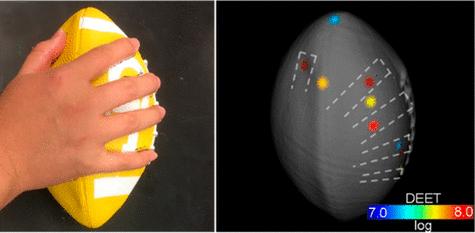Robotics takes mass spec to the third dimension for forensics, pharma applications

By combining a robotic arm and mass spectrometry, researchers can analyze the surface of 3-D objects, such as footballs. Credit: American Chemical Society
Mass spectrometry (MS) is a tool that helps researchers identify the components of a sample. In recent years, the instrument has made its way outside the laboratory for use in forensics and drug screening. But current MS techniques can not examine large, bulky, curved objects without a lot of human intervention.
Previously, Facundo M. Fernández and colleagues performed a proof-of concept study to show that a 3-D infrared camera could direct a robotic arm to collect samples for plasma ionization MS analysis, but only certain types of molecules could be studied with the method.
In the current work, the team wanted to expand on this idea of direct surface sampling of irregularly shaped 3-D objects.
The researchers developed a new method called robotic surface analysis MS (RoSA-MS). To do this, they attached a custom-built laser scanner to a force-sensing robotic arm. The laser scanner created a digital map of the sample's surface, which directed a spring-loaded sampling probe — also attached to the arm — to certain locations.
The probe briefly contacted the surfaces of objects and collected trace amounts of the material. After collecting the sample, the arm placed the probe into an electrospray ionization mass spectrometer that can analyze a wide range of samples.
The researchers note that the probe could be tailored for different applications. For example, they used RoSA-MS to detect caffeine on the surface of a plastic coffee cup and to pinpoint the locations of pesticide residue on a small football.
###
The authors acknowledge funding from the National Science Foundation and the National Science Foundation Center for Chemical Evolution.
The abstract that accompanies this study is available here.
The American Chemical Society, the world's largest scientific society, is a not-for-profit organization chartered by the U.S. Congress. ACS is a global leader in providing access to chemistry-related information and research through its multiple databases, peer-reviewed journals and scientific conferences. ACS does not conduct research, but publishes and publicizes peer-reviewed scientific studies. Its main offices are in Washington, D.C., and Columbus, Ohio.
To automatically receive news releases from the American Chemical Society, contact newsroom@acs.org.
Media Contact
All latest news from the category: Life Sciences and Chemistry
Articles and reports from the Life Sciences and chemistry area deal with applied and basic research into modern biology, chemistry and human medicine.
Valuable information can be found on a range of life sciences fields including bacteriology, biochemistry, bionics, bioinformatics, biophysics, biotechnology, genetics, geobotany, human biology, marine biology, microbiology, molecular biology, cellular biology, zoology, bioinorganic chemistry, microchemistry and environmental chemistry.
Newest articles

NASA: Mystery of life’s handedness deepens
The mystery of why life uses molecules with specific orientations has deepened with a NASA-funded discovery that RNA — a key molecule thought to have potentially held the instructions for…

What are the effects of historic lithium mining on water quality?
Study reveals low levels of common contaminants but high levels of other elements in waters associated with an abandoned lithium mine. Lithium ore and mining waste from a historic lithium…

Quantum-inspired design boosts efficiency of heat-to-electricity conversion
Rice engineers take unconventional route to improving thermophotovoltaic systems. Researchers at Rice University have found a new way to improve a key element of thermophotovoltaic (TPV) systems, which convert heat…



